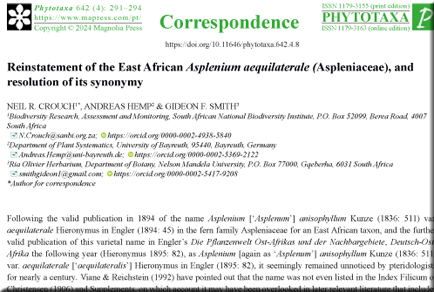Abstract
Following the valid publication in 1894 of the name Asplenium [‘Asplenum’] anisophyllum Kunze (1836: 511) var. aequilaterale Hieronymus in Engler (1894: 45) in the fern family Aspleniaceae for an East African taxon, and the further valid publication of this varietal name in Engler’s Die Pflanzenwelt Ost-Afrikas und der Nachbargebiete, Deutsch-Ost-Afrika the following year (Hieronymus 1895: 82), as Asplenium [again as ‘Asplenum’] anisophyllum Kunze (1836: 511) var. aequilaterale [‘aequilateralis’] Hieronymus in Engler (1895: 82), it seemingly remained unnoticed by pteridologists for nearly a century. Viane & Reichstein (1992) have pointed out that the name was not even listed in the Index Filicum of Christensen (1906) and Supplements, on which account it may have been overlooked in later relevant literature that includes Peter (1929), Faden (1973, 1974), and Jacobsen & Jacobsen (1989). Along with a specimen accessioned to Herb. B (Holst 2491), Viane & Reichstein (1992) relied on material collected by R.R. Schippers, held at Wageningen (Herb. WAG), to assess the status and position of Hieronymus’s variety. They deemed it recognisable at species rank and, accordingly, Viane published the name A. aequilaterale (Hieronymus in Engler 1895: 82) Viane in Viane & Reichstein (1992: 157), with Holst 2491 at Herb. B cited as the “holotype”. They recognised that the affinity of their species was not with A. anisophyllum in its present circumscription, but rather with the tropical African A. macrophlebium Baker in Hooker & Baker (1874: 485). The terrestrial A. aequilaterale was considered to grow in mid-montane forests between elevations of 1350 and 1950 m, within the South Pare and West Usambara mountains (Viane 1992). Schippers (1993) shortly thereafter extended the range of A. aequilaterale to include the North Pare mountains of Tanzania, and the Teita Hills of Kenya. He described it as a relatively common steep forest floor inhabitant, particularly in the South Pare and West Usambara mountains.
References
- Baker, J.G. (1874) 69* A. [splenium] macrophlebium, Baker. In: Hooker, W.J. & Baker, J.G. (Eds.) Synopsis filicum: or, a synopsis of all known ferns, including the Osmundaceae, Schizeaceae, Marattiaceae, and Ophioglossaceae (chieflly derived from the Kew herbarium) accompanied by figures representing the essential characters of each genus. 2nd edition. Robert Hardwicke, London, p. 485. [https://www.biodiversitylibrary.org/bibliography/55917]
- Beentje, H.J. (2008) Aspleniaceae. In: Beentje, H.J. & Ghazananfar, M.R.M. (Eds.) Flora of Tropical East Africa. Royal Botanic Gardens, Kew, 75 pp.
- Christensen, C. (1906) Index filicum sive enumeratio omnium generum specierumque filicum et hydropteridum. ab anno 1753 ad finem anni 1905 descriptorum adjectis synonymis principalibus, area geographica etc. H. Hagerup, Copenhagen, 744 pp. [https://bibdigital.rjb.csic.es/viewer/12943/?offset=#page=3&viewer=picture&o=bookmark&n=0&q=]
- Faden, R.B. (1973) Some notes on the gemmiferous species of Asplenium in Tropical East Africa. American Fern Journal 63 (3): 85–90. https://doi.org/10.2307/1546184
- Faden, R.B. (1974) Pteridophytes (ferns and fern allies) In: Agnew, A.D.Q. (Ed.) Upland Kenya wild flowers, a flora of the ferns and herbaceous flowering plants of Upland Kenya. Oxford University Press, London, pp. 13–74.
- Hemp, A. & Crouch, N.R. (2018) Asplenium arcumontanum (Aspleniaceae), a new species from the Eastern Arc Mountains of Tanzania. Kew Bulletin 73: article number 58. https://doi.org/10.1007/s12225-018-9777-y
- Hieronymus, G. (1894 [22. Mai]) Die Pteridophyten. Über die Gliederung der Vegetation von Usambara und der angrenzenden Gebiete. In: Abhandlungen der Königlichen Akademie der Wissenschaften zu Berlin 1894: 1–86. [https://www.biodiversitylibrary.org/item/92793#page/99/mode/1up]
- Hieronymus, G. (1895) Unterabtheilung: Pteridophyta. In: Engler, H.G.A. (Ed.) Die Pflanzenwelt Ost-Afrikas und der Nachbargebiete. Deutsch-Ost-Afrika, Theil C, Dietrich Reimer, Berlin, pp. 77–91. [https://www.biodiversitylibrary.org/item/10523]
- Hooker, W.J. (1861) A second century of ferns; being figures with brief descriptions of one hundred new, or rare, or imperfectly known species of ferns; from various parts of the world. Cent. 2. Dulau & Co., London, 100 plates. https://doi.org/10.5962/bhl.title.54283
- IPNI (2024+) The international plant names index. Available from: http://www.ipni.org (continuously updated; accessed January 2024)
- Jacobsen, W.B.G. & Jacobsen, N.H.G. (1989) Comparison of the pteridophyte floras of southern and eastern Africa, with special reference to high-altitude species. Bulletin du Jardin Botanique National de Belgique 59: 261–317. https://doi.org/10.2307/3668347
- Johns, R.J. (1991) Pteridophytes of tropical East Africa: a preliminary check-list of the species. Royal Botanic Gardens, Kew, 132 pp.
- Kunze, G. (1836) Acotyledonearum Africae australioris recensio nova. I. Filices. Linnaea 10: 481–570. [https://www.biodiversitylibrary.org/page/99842#page/516/mode/1up]
- Peter, A. (1929) Flora von Deutsch-Ostafrika. Zusammenstellung der in Deutsch-Ostafrika beobachteten farnartigen Gewächse und Blütenpflanzen mit Literatur-Nachweisen, Angabe der Verbreitung auf der Erde und Bestimmungshilfen. Repertorium specierum novarum regni vegetabilis, Beihefte Band XL, 1, Dahlem, Berlin.
- Plants of the World Online (2024+) https://worldfloraonline.org/taxon/wfo-0001120295 (continuously updated; accessed January 2024)
- Roux, J.P. (2009) Synopsis of the Lycopodiophyta and Pteridophyta of Africa, Madagascar and neighbouring islands. Strelitzia 23. South African National Biodiversity Institute, Pretoria, 296 pp. [https://www.sanbi.org/wp-content/uploads/2018/04/strelitzia-23-2009.pdf]
- Schippers, R.R. (1993) Pteridophytes of Tanzania with special reference to Pare and Usambara Mountains (Part 2). The Fern Gazette 14 (6): 193–214.
- Thiers, B. (2024 [continuously updated]) Index Herbariorum: A global directory of public herbaria and associated staff. New York Botanical Garden’s Virtual Herbarium. Available from: http://sweetgum.nybg.org/ih/ (accessed January 2024)
- Turland, N.J., Wiersema, J.H., Barrie, F.R., Greuter, W., Hawksworth, D.L., Herendeen, P.S., Knapp, S., Kusber, W.-H., Li, D.-Z., Marhold, K., May, T.W., McNeill, J., Monro, A.M., Prado, J., Price, M.J. & Smith, G.F. (2018) International Code of Nomenclature for algae, fungi, and plants (Shenzhen Code) adopted by the Nineteenth International Botanical Congress Shenzhen, China, July 2017. Koeltz Botanical Books, Glashütten. [Regnum Vegetabile 159], 254 pp. https://doi.org/10.12705/Code.2018
- Viane, R.L.L. & Reichstein, T. (1992 [25 June]) Notes about Asplenium II: some new names and combinations in Asplenium L. (Aspleniaceae, Pteridophyta). Biologisch Jaarboek; uitgegeven door het k. natuurwetenschappelijk genootschap Dodonaea te Gent 59: 157–165.
- Wright, C.H. (1908) XXXIV.—Diagnoses Africanae: XXIII. Asplenium (Euasplenium) Elliottii C. H. Wright [Filices—Polypodiaceae]. Kew Bulletin of Miscellaneous Information 1908: 257–262. https://doi.org/10.2307/4111575


